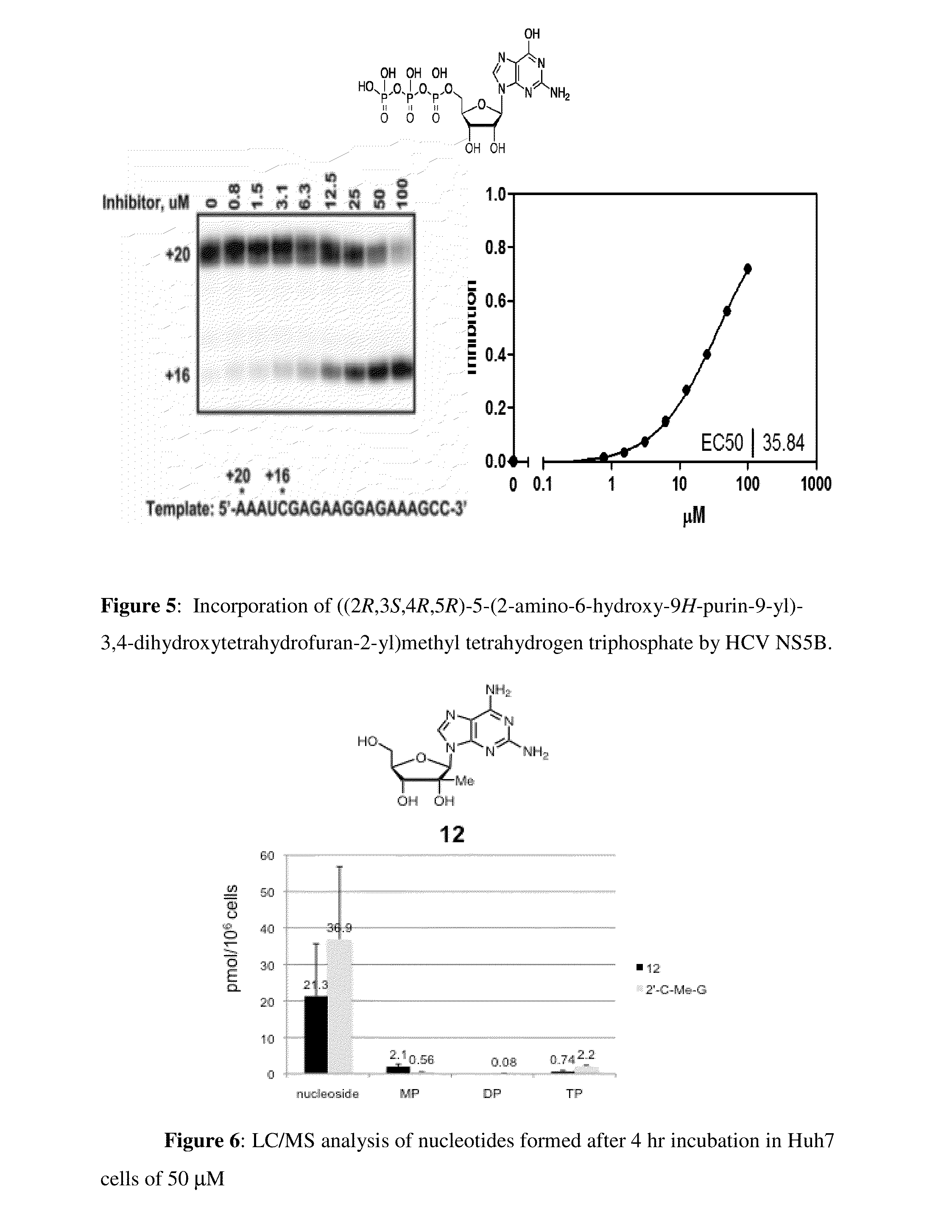Purine monophosphate prodrugs for treatment of viral infections
a technology of purine monophosphate and prodrugs, which is applied in the direction of biocide, group 5/15 element organic compounds, peptide/protein ingredients, etc., can solve the problems of long time-consuming and laborious, significant side effects, and inability to easily carry out cell cultur
- Summary
- Abstract
- Description
- Claims
- Application Information
AI Technical Summary
Benefits of technology
Problems solved by technology
Method used
Image
Examples
specific examples
[0176]Specific compounds which are representative of this invention were prepared as per the following examples and reaction sequences; the examples and the diagrams depicting the reaction sequences are offered by way of illustration, to aid in the understanding of the invention and should not be construed to limit in any way the invention set forth in the claims which follow thereafter. The present compounds can also be used as intermediates in subsequent examples to produce additional compounds of the present invention. No attempt has necessarily been made to optimize the yields obtained in any of the reactions. One skilled in the art would know how to increase such yields through routine variations in reaction times, temperatures, solvents and / or reagents.
[0177]Anhydrous solvents were purchased from Aldrich Chemical Company, Inc. (Milwaukee). Reagents were purchased from commercial sources. Unless noted otherwise, the materials used in the examples were obtained from readily avai...
example 1
Synthesis of 2,6-Diamino Purine 2′-C-Me Monophosphate Prodrugs 8a and 8b
[0178]
(2R,3R,4R,5R)-5-((Benzoyloxy)methyl)-2-(2,6-diamino-9H-purin-9-yl)-3-methyltetrahydrofuran-3,4-diyl dibenzoate 3
[0179]To a stirred suspension of (3R,4S,5R)-5-((benzoyloxy)methyl)-3-methyltetrahydrofuran-2,3,4-triyl tribenzoate 1 (2.9 g, 5 mmol) and 2,6-diaminopurine 2 (830 mg, 5.5 mmol) in anhydrous acetonitrile at −78° C. was added DBU (2.3 mL, 15.0 mmol), followed by a slow addition of TMSOTf (3.8 mL, 20.0 mmol). The reaction mixture was stirred at −78° C. for 20 min, and then raised to 0° C. After stirred 30 min at 0° C., the reaction mixture was heated gradually to 65° C., and stirred overnight. The reaction mixture was diluted with CH2Cl2 (200 mL) and washed with saturated NaHCO3. The layers were separated and the resulting aqueous layer was extracted with CH2Cl2 (2×20 mL). The combined organic layers were dried over Na2SO4. After removal the solvent, the residue was purified by silica gel column chro...
example 2
Synthesis of 2,6-Diamino Purine 2′-C-Me Monophosphate Prodrug 11
[0185]
Ethyl 3-(2-(((((2R,3R,4R,5R)-5-(2,6-diamino-9H-purin-9-yl)-3,4-dihydroxy-4-methyltetrahydrofuran-2-yl)methoxy)(2-(3-ethoxy-3-oxopropyl)phenoxy)phosphoryl)oxy)phenyl)propanoate, 11
[0186]To a solution of 5 (630 mg, 0.91 mmol) and N-methylimidazole (0.35 mL, 4.5 mmol) in THF (3 mL) at 0° C. was added dropwise a solution of diethyl 3,3′-(((chlorophosphoryl)bis(oxy))bis(2,1-phenylene))dipropanoate 9 in THF (9 mL, 4.5 mmol). The resulting mixture was stirred overnight at rt. After removed the solvent under reduced pressure, the residue was purified by flash column chromatography in a gradient of MeOH (0% to 10% MeOH in CH2Cl2) to afford 540 mg white solid 10 (53% yield). A pre-cold (3. After removal of the solvent, the residue was purified by flash column chromatography (0% to 15% MeOH in CH2Cl2) to afford 270 mg of 11 as a white solid (77%). LC / MS calcd. for C22H30N7O8P 728.2, observed: 729.3 (M+1).
PUM
| Property | Measurement | Unit |
|---|---|---|
| time | aaaaa | aaaaa |
| time | aaaaa | aaaaa |
| temperatures | aaaaa | aaaaa |
Abstract
Description
Claims
Application Information
 Login to View More
Login to View More - R&D
- Intellectual Property
- Life Sciences
- Materials
- Tech Scout
- Unparalleled Data Quality
- Higher Quality Content
- 60% Fewer Hallucinations
Browse by: Latest US Patents, China's latest patents, Technical Efficacy Thesaurus, Application Domain, Technology Topic, Popular Technical Reports.
© 2025 PatSnap. All rights reserved.Legal|Privacy policy|Modern Slavery Act Transparency Statement|Sitemap|About US| Contact US: help@patsnap.com



